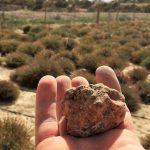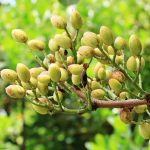
PROFITABLE AND RISING CROPS: PISTACHIO
Introduction
A profitable crop is established as one that allows the initial investment to be recovered in a relatively short period of time or as quickly as possible. It is also defined as one in which the benefits of its sale are well above the investment to be made. In this publication we will analyze some of the crops considered the most profitable for 2020, among which are pistachio, almond, avocado, mango, blueberry, hops, arnica, calendula and lavender. For each one of them, their agronomic needs will be established, since not all of them develop adequately in any type of soil and under all types of weather conditions.
In short, when starting any of the previously mentioned crops, a series of conditions must be taken into account, that is, a detailed study of the characteristics of the area must be carried out. This is key, since production and, therefore, income will depend on it. Likewise, the current market situation must be analysed, as well as future prospects and the product’s sale price. Finally, it will be convenient to make a calculation of estimated costs, since its difference with the benefits will make it a profitable crop or not.
Pistachio
Pistachio cultivation is currently on the rise in the market, so you can establish, without a doubt, that it is a profitable crop today. However, it must be borne in mind that the market is highly variable over time, so its profitability can only be guaranteed in the short term. It is a relatively simple crop, since its needs are not very numerous, and it can grow in practically any type of soil, as long as good drainage is guaranteed. In addition, its temperature tolerance range is very wide, withstanding up to 50 ºC in summer and winters in which -30 ºC are reached. The main drawback of this crop is that a stable production level is not reached until between 3 and 7 years, depending on whether already grafted stems or stems to be grafted are planted.
General characteristics
The pistachio tree (Pistacia vera) is a deciduous tree, as a general rule, of small size, although it can reach between 7 and 10 meters in height on certain occasions, depending on the variety that is being cultivated. The bark is rough with grayish tones and has abundant ramifications, as well as a dense crown. Its root system is capable of reaching great depths, thanks to a highly developed taproot, which makes it a species capable of growing in drier climates.
It is a dioecious tree, that is, it has male and female individuals, so that the male and female flowers are on different feet. Floral differentiation occurs in the year prior to flowering and male trees generally initiate flowering before female trees.
It has two types of buds, which are called vegetative or wood buds and flower buds. In the early stages of development, all the buds of the tree are vegetative, while later on the flower buds prevail, leaving only one or two wood buds on the new shoots. The wood buds appear after flowering, that is, approximately in April and are smaller than the fruit buds. Of all of them, the largest is the terminal one, which is thicker and earlier, as a consequence of apical dominance. The flower buds are arranged in the axils, at the rate of one per axil.
Pollination, which begins with the arrival of pollen grains on the stigma and fertilization, are essential for the formation and setting of the fruits. Its pollination is anemophilous, which means that the transfer of pollen is carried out by the action of the wind. The dehiscence of the fruits is a very particular characteristic of this species, which corresponds to the opening of the suture that joins the two valves of the fruit, which makes it easier for the consumer to open it, in the event that it is marketed with the shell.
Environment conditions
Taking into account its characteristics, previously described, specifically due to its root system, the pistachio requires deep soils, that is, that have a thickness of at least 2 meters of weathered soils and little non-compacted mother. It develops correctly in alkaline soils with a pH above 7.5 and silty, that is, with a coarse-grained or sandy-loam texture.
In relation to temperatures, it is established that it is a typical species with long, hot and dry summers, despite which it requires between 700 and 2000 hours of winter rest. This implies that for about 30 or 40 consecutive days, the average temperature should not exceed 7.2 ºC. If the winter rest is not enough, flowering and pollination will be deficient, which will result in a reduction in production. However, late frosts in early May can damage the shoots, although the tree may regrow from a lower bud than flower. Likewise, it is necessary that once the average temperature is established above 8 ºC, this is maintained so that the tree accumulates a number of hours of heat, thus guaranteeing flowering. This phenomenon thus determines the dates and periods of flowering.
It has a high tolerance to drought, with the minimum rainfall to achieve an acceptable production level of 350 mm. It does not tolerate prolonged wet conditions in the soil, which means that its optimal growth is achieved in well-drained soils. For this reason, the ideal irrigation method is localized, since it avoids waterlogging. This should be done abundantly, since the tree reacts better to smaller risks more frequently.
Management
The most common way of pistachio production is rainfed. Despite this, it is necessary to take into account that in order to obtain an optimum level of yield, an irrigated crop or one with deficit irrigation is required. A plantation is considered to be irrigated when a supply of water is carried out to cover the demands of the tree. In deficit irrigation, water is supplied strategically based on the phenology of the crop, but always with quantities above 1000 m3/ha/year. The main objective is to obtain the highest performance with the lowest consumption. These regimens also guarantee a greater opening of the fruit, a highly appreciated feature in the market, which has a direct impact on the visual quality of the product, affecting its profitability. In short, water is an important factor to ensure increased productivity and quality of the harvest. The main disadvantage is the loss of organoleptic quality of the fruits compared to those obtained in a dry culture. Likewise, it is also necessary to be careful, since an increase in the environmental relative humidity is associated with an increase in the risk of incidence of pests, which together with narrow plantation frames and lack of pruning, can lead to a reduction in the quantity and quality of the harvest.
Therefore, once the decision has been made on the model to be implemented (rainfed or irrigated), a plantation framework must be established, based on the characteristics of the land and the availability of water. This is a determining point, since it will have a great influence on different aspects. The minimum frame is 7 x 7 m, increasing it in shallow rainfed soils, since failure to do so runs the risk that the roots will not be able to expand enough through the soil to ensure water intake without having to compete by resource with another tree. In addition, in deep soils and with water availability, although a priori it might seem more favorable to join the trees, it should be considered that over time the size will be greater and they could compete for light, nutrients and water. reducing photosynthetic efficiency. To alleviate this situation, drastic pruning would be necessary, resulting in a weakening of the tree.
Pruning
A distinction can be made between two types of pruning, which are formation pruning and production pruning. Training pruning is one that is carried out during the first 5 or 8 years, depending on the point at which the tree reaches the point of full production. Its objective is to ensure that the tree acquires the desired shape, considering the ideal shape to be a glass with three main branches and a cross height that does not exceed one meter. In this way, better yields are achieved and harvesting is easier. From that moment on, production pruning is carried out in winter, every productive year. Its objective is to achieve aeration and luminosity inside the glass, thus maintaining production levels.
Plagues and diseases
Green bug (Nezara viridula): species of hemiptera insect that gives off an intense irritating odor when it feels threatened or is stepped on. Due to its physical characteristics, its detection becomes complex. However, it represents a great danger, since in addition to depreciating the quality of the fruits, which wither or present deformations and dark spots, in cases in which it is not controlled in time, it can cause a total loss of fruit. Harvest. It mainly causes stippling in the leaves, which, when unfolding, tend to break relatively easily in those stippled areas. The eggs are arranged on the underside of the leaf in a hexagonal shape, in the form of a honeycomb.
Piral or seed ink (Plodia interpunctella): species of lepidoptera, also known by the name of banded moth of dried fruits. This moth can trigger direct losses, as well as indirect economic costs, as a result of quality losses and consumer complaints. It affects stored and packaged products, for which it is necessary to keep the storage place clean, paying special attention to cracks and corners. Food and packaging must also be checked, in order to detect if there are other compromised foods, their elimination being essential. The damage occurs due to the entry of the larvae into the fruit, where they make galleries, causing contamination due to the presence of exuvia and silk remains.
Pistachio psyllas (Agonoscena pistaciae): species of hymenoptera, whose adults are dark yellow, sometimes also dotted with black. Its visual detection is relatively simple, since characteristic cottony masses are formed on the leaves. On the underside of them it is also possible to observe the nymphs of yellowish and orange tones, which is the place where they feed. Both the adults and the more immature stages base their feeding on the ingestion of plant sap, which triggers a reduction in growth, also causing a drop in the shoot, which results in defoliation, fruit drop and, therefore, therefore, in a considerable reduction in crop yield.
Clytra or beetle (Labidostomis lusitanica): belonging to the Coleoptera genus, a beetle that is small in size, compact in appearance, and has sexual dimorphism, within the same species, so that males are larger than females. Its head and pronotum are black and the elytra have a striking orange color with a black dot at the beginning, which makes it easy to recognize. They feed in spring on tender leaves, mainly new shoots, which can lead to defoliation of the tree. They lay their eggs near anthills, where they travel after hatching, colonizing the nest and feeding on the ants’ waste.
Castañeta (Vesperus xatarti): beetle with a very short adult lifespan, which ends once mating occurs and the eggs are laid, which are easily recognizable, since they are arranged as a whitish spot, fixed with a substance mucilaginous, which hardens, thus serving as protection. Spawning takes place on the bark of the trees, from where the larvae emerge, moving short distances, in order to reach the outside and reach the ground, where they bury themselves in search of the roots, on which they feed. Damage occurs as a consequence of this fact, which leads to a limitation of the crop’s ability to assimilate nutrients. If the tree is very young, it is possible that it will destroy it completely in a short time. In older trees, the symptoms that appear can be confused with those of other problems, since their vigor decreases, they are weakened and the harvest is much lower than it should be, with small-sized fruits.
Cochineal (Saessetia oleae): homopterous insect, whose best known form is the adult female, dark brown in color, which protects the eggs under its shell, whose laying takes place without the need for fertilization to occur. Given the scarcity of males and the aforementioned characteristic, it can be established that the reproduction of this species of cochineal is parthenogenetic. When the first larvae appear, mobile at first, until they settle definitively, they move to the new shoots, generally on the bundle and more specifically on the central nerve. One of the main damages it produces is due to the excretion of molasses, which favors the establishment of what is known as the bold fungus, which forms a black layer on the leaves, similar to soot, which prevents the incidence of the sun. thus reducing photosynthetic activity. Also, due to the suction of sap, they cause a general weakening.
Botryosphere (Botryosphaeria dothidea): pistachio disease, which receives this name from the fungus that produces it. It is characterized by the formation of a series of sores, which appear as depressed lesions of the bark, without an obvious color change, compared to the healthy bark. For this reason it is also called canker, whose extension can reach the entire length of a branch. As a consequence of the appearance of these lesions, the leaves progressively wither, that is, they lose turgidity, until they are folded and stuck to each other, thus remaining attached to the branch for a long period of time, until they end up falling. Regarding the progression of the symptoms in the affected branch, at first it will be possible to observe the necrosis of the apex and the wilting of the young leaves. Subsequently, these symptoms develop and worsen from the apex to the most proximal end of the branch. This advance is known as regressive death and can appear only in one branch or in several of the same tree.
Verticillium wilt (Verticillium dahliae): disease caused by the action of the pathogenic fungus that gives it its name, which leads to discoloration and rolling of the leaves. It can even cause the death of the tree, since its branches gradually dry out. Its transmission can occur between trees of the same species or by contagion through a host, such as adventitious species and other species cultivated in adjoining areas. The fungus infects the tree through the roots, taking advantage of lesions on its surface produced by work carried out by the farmer or by the action of other living beings, such as insects or nematodes. Once it has reached the interior, the mycelium of the fungus spreads, relatively quickly, through the vascular system, producing a reaction to the viscous substances produced by the pathogen, which clog the conductive vessels.
Alternaria, alternariosis or late blight (Alternaria alternata): produced by an opportunistic pathogenic fungus, which takes advantage of any type of opening available to access the host, such as wounds or those of a natural type, such as lenticels, specialized structures, circular in shape and elongated, which ensure the entry of oxygen, that is, gas exchange. The symptoms begin to appear in the basal leaves, to later continue advancing to the upper strata. At first, the leaves acquire a yellowish hue at the tip, which gradually develops along the margins to the petiole. Then a series of spots appear on the leaves with a variable size, which have a purple border, while the center is whitish or more brownish. Necrotic tissue breaks can occur in the center of the lesion.
Pistachio rust (Pileolaria terebinthi): the fungus that produces this disease completes its entire cycle in trees, specifically in all those belonging to the Pistacia genus. Its transmission occurs through the air, by means of basidiospores, which are reproductive spores. During winter, overwintering structures can be found on fallen leaves on the ground, developing again once temperatures exceed 15°C. The symptoms begin with the appearance of a series of necrotic spots on the leaves, characterized by being brown in color and surrounded by a fine yellowish margin. On certain occasions there may be a perforation of the limbs. Over time, the spots become darker and more powdery and eventually spread over the entire surface, until they become a mass of dark brown necrotic tissue. In a severe infection, tree defoliation can be a concern. The pustules can also be found on the fruits.
Septoria (Septoria pistaciae, Septoria pistaciarum and Septoria pistacina): this disease, caused by the action of various ascomycete fungi, has been found in all pistachio-producing countries. As in the previous cases, the symptoms consist of the appearance and development of irregular necrotic spots. However, in this pathology the spots, although they can be very numerous on the same leaf, continue to maintain a reduced size, thus remaining isolated from each other. Trees that are not treated will suffer early defoliation and the following year will suffer a weakening. The fungus overwinters in fallen leaves, which have been infected in the previous season. The ascospores, when they are mature and ready for discharge, are released during and after rain.





